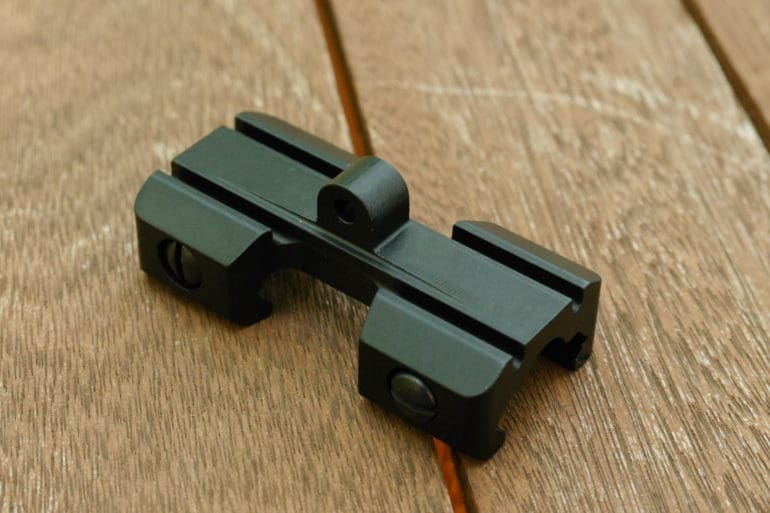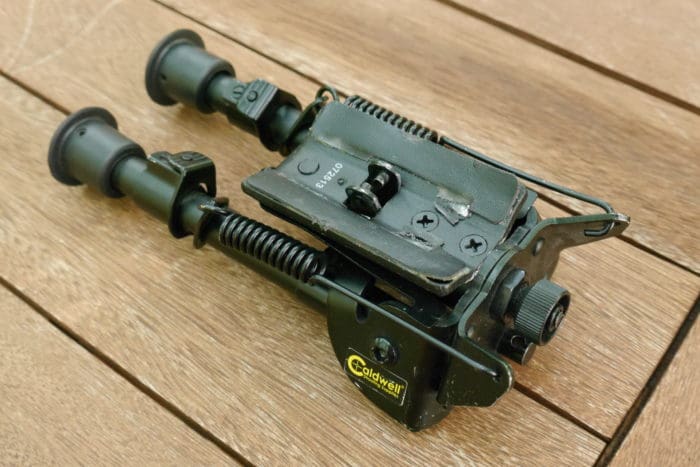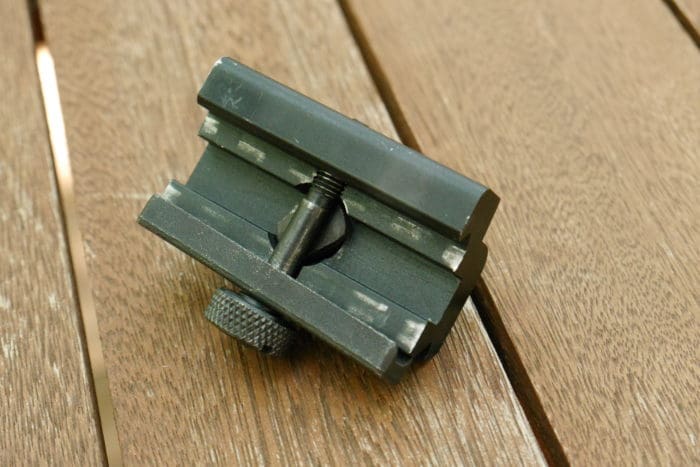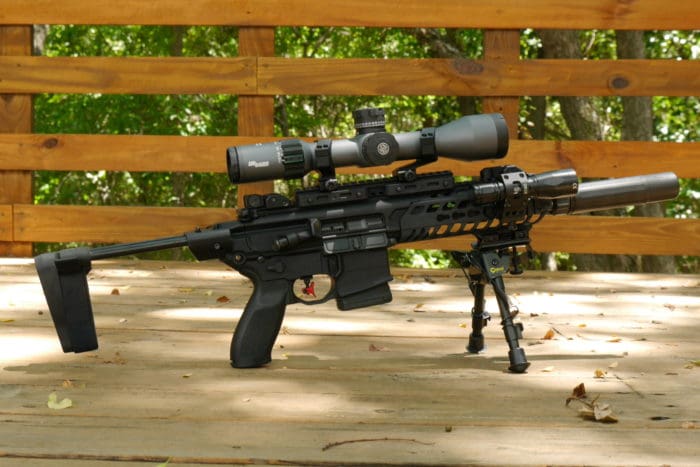It’s been a while since I posted something around here. Damn near four months, actually — the longest vacation I’ve ever taken from writing at TTAG since I joined over six years ago. Truth be told I’ve been a bit busy buying a house and changing day jobs, but something came across my desk that interested me so much that I was compelled to test it out and write it up. That thing: the Mission First Tactical E-VolV Picatinny Bipod Mount.
You may be scratching your heads about why this got my attention. Let me explain.
When reviewing a new firearm, one of the more important aspects of the write-up is the accuracy test. An expensive rifle that shoots groups bigger than Chris Christie’s waistline isn’t exactly something worth spending your hard-earned money on. To make the test as fair to the rifle as possible, in addition to a good scope, I also mount a bipod on the bottom of the gun. Removing as much of the error as possible (in this case, shooter induced error) is critical.
As you might expect, I use the same bipod for pretty much every review. This bipod, specifically — the cheapest Caldwell Shooting Supplies bipod I could possibly find. It’s not the greatest set of legs in the world, but it works for my purposes and has the same features that you’d expect to find on other bipods on the market. And it uses the industry standard sling stud bipod mounting system.
Throughout the entire 20th century the only place to mount a bipod on the bottom of a rifle was the sling swivel stud — a small metal nub that’s screwed or otherwise affixed to the bottom of the rifle’s forend, designed to allow the shooter to attach a sling and carry the gun around with more ease.
The size and shape of these sling swivel studs have standardized over time and bipod manufacturers have designed their devices to hook into the little studs to mount them snugly onto the gun. When the only other alternative is drilling holes in your pretty walnut stock, it’s a kludge that makes a lot of sense.
But kids these days are moving away from the traditional wood stock and instead seem to enjoy slapping Picatinny rails on every available surface — including the underside of an AR-15 handguard.
Some manufacturers have started producing bipods with Picatinny adapters, but the majority of the market has simply kept using the same mounting system they’ve used for generations. That led to the rise of bipod adapters like this one here. It’s the adapter I use to attach my testing bipod to the test rifles, made by a manufacturer I’ve long forgotten and purchased for less than an Andrew Jackson.
It works, and for how I use it, the design makes sense. It’s a two-piece mount — the majority of the mount is a rigid structure with one side of the mount as a separate piece that moves independently. That allows the mount to be easily placed on a rail and removed again when needed. A single bolt acts both to tighten the pieces when needed and to absorb all the recoil when placed on the firearm.
That’s kind of where things go off the rails for me, so to speak. Having a single bolt for all that recoil localizes the stress on the rail system and has led to some unintended wear and tear on loaner guns in the past. And the clamp system is good in theory, but after a couple of days of hard use it usually needs to be tightened down or it will come loose and disconnect from the rifle (typically when I need it the most).
That’s where MFT’s E-VolV Bipod Mount comes in. There are a couple of design changes here that I really like.
First, the E-VolV is machined out of a single piece of aluminum. Even if the bolts start to loosen, the design reduces the likelihood that it will fall off when in use. Even with the bolts gone, the mount is still marginally useful. You just can’t actually “load” it (push forward into the bipod for a more stable shooting platform).
The mount clamps tightly onto the rail, with appropriate cuts made to allow it to flex enough to put a good bit of friction on the rail to keep the mount in place.
While we’re down here looking up the mount’s skirt, you’ll notice that there are two bolts instead of one. This spreads the force of the loading and recoil out much better across the rail, reducing the probability of damage and strengthening the mount itself. It also allows for a tighter grip on the rail since the two bolts can apply more pressure than a single bolt could accomplish.
Finally, the nub. On the old mount the nub rotated, in this case it’s machined into the mount itself. There are other mounts on the market that do the same thing but I appreciated this detail personally.
So, how does it work in practice?
I slapped this mount and bipod on my current long range setup, a suppressed SIG SAUER MCX pistol in 300 BLK. Immediately the benefits were apparent — the added stability from the tighter mount was immediately noticeable, and even after a full afternoon lobbing subsonic 300 BLK rounds at a 300 yard target it was still as steady as a rock.
Oh, I tried it on other stuff too. Everything from a SCAR 17 to my Remington 700 benefited from the added stability.
Complaints? I don’t have many. The design of the sling stud bipod mount means that you need to slide it the entire length of the rail to install or remove it, you can’t put it on directly. That’s a pain if you’re running lights or lasers on the same rail section, but honestly you’ll only need to do it once and be done with it. Other than that it’s a fine piece of engineering that works exactly as intended.
Mission First Tactical E2BPM Picatinny Rail Bipod Adapter
MSRP: $34.99
Rating (out of five stars):
Overall * * * * *
Simple. Effective. Well-engineered aluminum construction. Easy mounting. Attaches to any mil-std Pic rail. I only wish the same could be said of the shelving unit I just constructed in my new garage.










So as far as I can tell, you can use
1) Bipod mount attached to handguard via M-Lok or Keymod connection like this https://www.magpul.com/products/m-lok-bipod-mount
2) Bipod
Or you can use
1) Picatinny rail section attached to handguard via M-Lok or Keymod connection
2) This revolutionary Mission First Tactical E-VolV Picatinny Bipod Mount
3) Bipod
That is if you don’t have an obsolete handguard covered with permanent picatinny rails, formerly referred to as a quad rail, now referred to as a “cheese grater.”
I tend to favor solutions with fewer parts.
Great write up. Im thinking-
Ruger lcp -> trigger guard picatinny add-on -> MFT’s E-VolV Bipod mount -> 3 point m1919 machine gun mount -> profit
“I slapped this mount and bipod on my current long range setup, a suppressed SIG SAUER MCX pistol…”
A *pistol* is your long-range setup?
Congrats on the house, it’s a nice feeling closing the front door and saying to yourself “mine.”
If that’s your back deck, are you planning a Hickok45-style backyard range?
“A *pistol* is your long-range setup?”
Chambered in 300BLK, no less. For when you REALLY need to reach out and touch someone.
I think maybe certain parts of this review were written with tongue in cheek.
Whatever . . . .300 BLK is overrated since it’s not a Creedmoor . . .
By the way, Nick, glad to see you are back! Congratulations on the new home and job!
Not a bad price at all.
(Congrats on the home)
So … When’s the housewarming party and what should we bring?
Seriously – congrats, it’s a nice feeling.
Thanks Foghorn, don’t be a stranger!
Whooo! Ive honestly missed your writing and opinions on subjects. Also the sweet gear reviews (the reviews that is, not all gear is so sweet lol)
Congrats on the house!
Comments are closed.